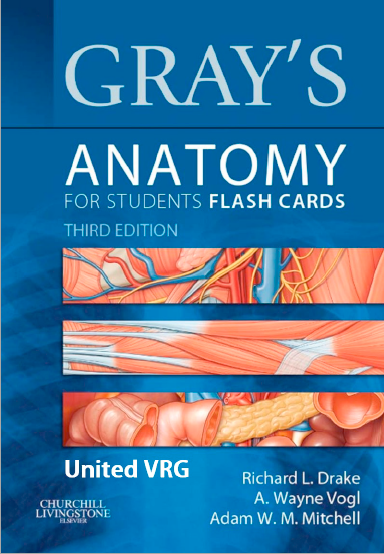In this Blog, you can easily download free pdf of Gray's Anatomy for Students (Flash Cards) 3rd Edition, edited by Richard L. Drake, A. Wayne Vogl, Adam W. M. Mitchell
About Book
Gray’s Anatomy for Students Flash Cards have tested to be a precious studying resource for college students hoping to beautify their appreciation of human anatomy, and the third version continues this tradition. The question-and-answer layout stimulates learning, and pertinent scientific information on most playing cards offers relevance. Each series contains:
• Introductory overview playing cards with facts about the skeletal, muscular, and cardiovascular structures in general, and floor aspects of the body
• Regionally prepared playing cards demonstrating fundamental anatomy
• Surface anatomy cards displaying essential anatomical landmarks associated to floor buildings and medical points
• Nervous machine playing cards containing records about precise components of the worried system
• **New to this edition**—Imaging playing cards with frequent CT and MRI views of the physique In addition, a variety of illustrations for the duration of the regional playing cards have been revised to correlate with modifications made in the third version of Gray’s Anatomy for Students.
It is our hope that the third version of the Gray’s Anatomy for Students Flash Cards will make your gaining knowledge of greater environment friendly and productive.
Summarizing, Gray’s Basic Anatomy makes use of a regional approach, comparable to Gray’s Anatomy for Students, with eight chapters: The Body, Back, Thorax, Abdomen, Pelvis and Perineum, Lower Limb, Upper Limb, and Head and Neck. The art work offers the equal acquainted illustrations from Gray’s Anatomy for Students, however they have been resized to inside a smaller layout whilst maintaining a shut bodily place to the textual content with which every gure is associated.
Finally, whilst some verbiage has been scribed in retaining with the intention of offering a concise textbook of anatomy (e.g., muscle descriptions have for the most phase been integrated into tables with no loss of content), additional scientific and imaging fabric has been delivered to beautify mastering in context.
This 2d version consists of several edits ensuing from reader feedback, some new and revised gures, and revisions primarily based on present day lookup in the eld of the anatomical sciences.
We hope you will proceed to nd this new version a beneficial and treasured useful resource whether or not you are an educator or a student.
What is anatomy?
Anatomy consists of these constructions that can be considered grossly (without the resource of magnication) and microscopically (with the resource of magnication). Typically, when used by way of itself, the time period anatomy tends to imply gross or macroscopic anatomy—that is, the learn about of buildings that can be viewed besides the use of a microscopic. Microscopic anatomy, additionally referred to as histology, is the learn about of cells and tissues the use of a microscope.
Observation and visualization are the essential techniques a scholar need to use to examine anatomy. Anatomy is a great deal extra than simply memorization of lists of names. Although the language of anatomy is important, the community of facts wished to visualize the role of bodily constructions in a affected person goes some distance past easy memorization.
Knowing the names of the more than a few branches of the exterior carotid artery is now not the equal as being capable to visualize the direction of the lingual artery from its starting place in the neck to its termination in the tongue. An under-standing of anatomy requires an perception of the context in which the terminology can be remembered.
HOW CAN GROSS ANATOMY BE STUDIED?
The time period anatomy is derived from the Greek phrase temnein, which means “to cut.” Clearly, at its root, the find out about of anatomy is linked to dissection. Dissection of cadavers by way of college students is now augmented, or even in some instances replaced, by using viewing prosected (previously dissected) fabric and plastic models, or the usage of laptop educating modules and different mastering aids.
Anatomy can be studied following both a regional or a systemic approach.
With a regional approach, every place of the physique is studied one by one and all factors of that vicinity are studied at the equal time. For example, if the thorax is to be studied, all of its constructions are examined.
This consists of the vasculature, nerves, bones, muscles, and all different buildings and organs positioned in the location of the physique dined as the thorax. After reading this region, the different areas of the physique (i.e., the abdomen, pelvis, decrease limb, top limb, back, head, and neck) are studied in a comparable fashion.
Download Link 1
Download Link 2

